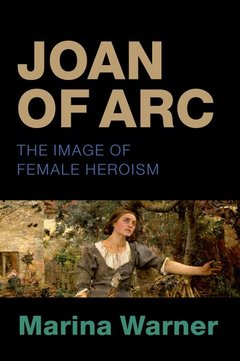Description
Joan of Arc
The Image of Female Heroism
Author: Warner Marina
Language: English
Publication date: 03-2016
402 p. · 15.5x23.4 cm · Paperback
402 p. · 15.5x23.4 cm · Paperback
Description
/li>Biography
/li>
The fame of Joan of Arc began in her lifetime and, though it has dipped a little now and then, she has never vanished from view. Her image acts as a seismograph for the shifts and settlings of personal and political ideals: Joan of Arc is the heroine every movement has wanted as their figurehead. In France, anti-semitic, xenophobic, extreme right parties have claimed her since the Action Francaise in the 19th century. By contrast, Socialists, feminists, and liberal Catholics rallied to her as the champion of the dispossessed and the wrongly accused. Joan of Arc has also played a crucial role in changing visions of female heroism. She has proved an inexhaustible source of inspiration for writers, playwrights, film-makers, performers, and composers. In a single, brief life, several of the essential mythopoiec characteristics that throughout history have defined the charismatic leader and saint are powerfully and intensely condensed. Even while Joan of Arc was still alive, but far more so after her death, the heroic part of her story sparked narratives of all kinds, in pictures, ballads, plays, and also satires. This was only heightened in 1841-9 by the publication of the Inquisition trial which had examined Joan for witchcraft and heresy. The transcript of the interrogations gives us the voice of this young woman across the centuries with almost unbearable immediacy; her spirit leaps from the page, uncompromising in its frankness, good sense, courage, and often breathtaking in its simple effectiveness. Joan of Arc into one of the most fully and vividly present personalities in history, about whom a great more is known, in her own words and at first hand, than is, for example, about Shakespeare. However, this has not stopped the flow of fictions and fantasies about her. Marina Warner analyses the symbolism of the Maid in her own time and in her rich afterlife in popular culture. The cultural expressions are part of an ongoing historical struggle to own the symbol - you could say, the brand. In a new preface to her study, Marina Warner takes stock of the continuing contention, in politics and culture, for this powerful symbol of virtue. Joan of Arc's multiple resurrections and transformations show how vigorous the need for figures like her remains, and how crucial it is to meet that need with thoughtfulness. She argues that abandoning the search to identify heroes and define them, out of a kind of high-minded distaste for propaganda, lets dangerous political factions manipulate them to their own ends. When Marine Le Pen calls on Joan of Arc's name, she needs to be confronted about her bad faith and her abuse of history.
Marina Warner's award-winning studies of mythology and fairy tales include Monuments & Maidens: The Allegory of the Female Form (l985) and No Go the Bogeyman: Scaring, Lulling and Making Mock (1998). Her Clarendon Lectures Fantastic Metamorphoses; Other Worlds were published in 2002; her essays on literature and culture were collected in Signs & Wonders (2000), and Phantasmagoria, a study of spirits and technology, appeared in 2006. Marina Warner was created a Chevalier de l'Ordre des Arts et des Lettres by the French in 2002, and a Commendatore by the Italians in 2005. She was awarded the Warburg Prize in Germany in 2004, and is an Honorary Fellow of Lady Margaret Hall, Oxford. She is Professor of Literature, Film and Theatre Studies at the University of Essex and President of the British Comparative Literature Association. In 2005 she was elected a Fellow of the British Academy. Oxford gave her an Honorary Doctorate in 2005.
© 2024 LAVOISIER S.A.S.
These books may interest you

Fresh Verdicts on Joan of Arc 58.78 €



